What the f*ck are Bezier Curves?
 Dhruvvv
Dhruvvv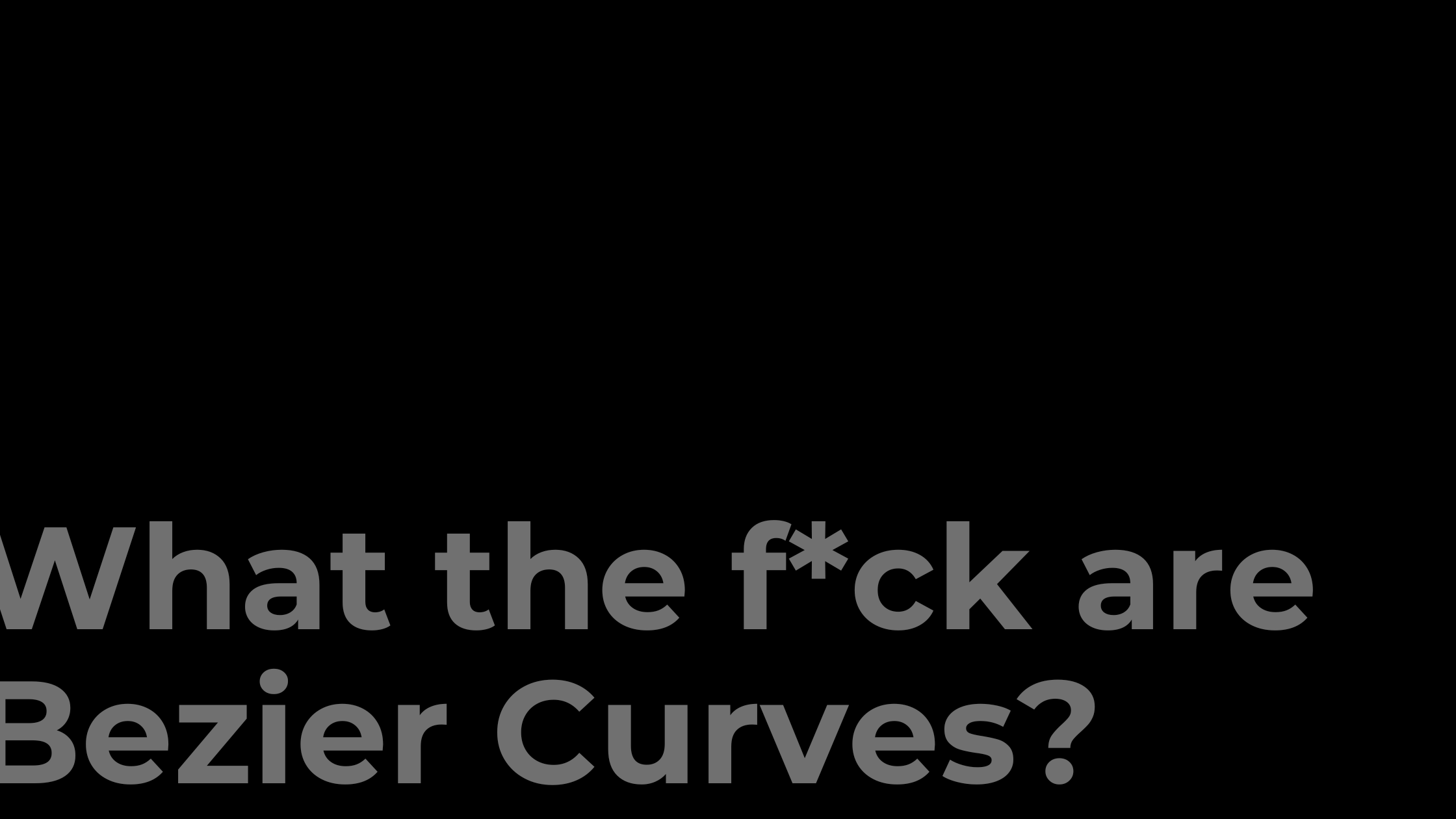
In computer graphics, we often need to draw different types of objects onto the screen. Objects are not flat all the time and we need to draw curves many times to draw an object.
A curve is an infinitely large set of points. Each point has two neighbors except endpoints.
Bezier curve is discovered by the French engineer Pierre Bézier. These curves can be generated under the control of other points. Approximate tangents by using control points are used to generate curve. The Bezier curve can be represented mathematically as −

Where n is the polynomial degree, i is the index, and t is the variable.
Whoa! That's a lot of information, isn't it? Well... Let's start with the very basics.
A Bezier Curve is parametric curve defined by a set of control points. Curves having parametric form are called parametric curves. The following curve is an example of a bezier curve-
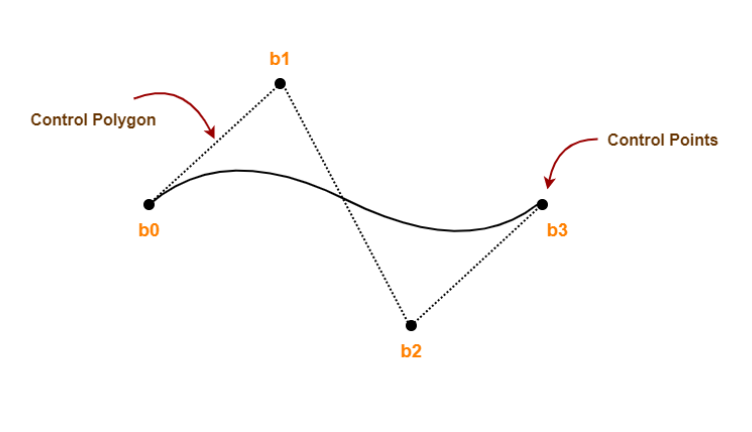
This bezier curve is defined by a set of control points b0, b1, b2 and b3.
Points b0 and b3 are ends of the curve.
Points b1 and b2 determine the shape of the curve.
01 . Properties of Bezier Curves 🪝
There are a few important properties of the Bezier Curves one must know:
Bezier curve is always contained within a polygon called as convex hull of its control points. The convex hull property for a Bezier curve ensures that the polynomial smoothly follows the control points.
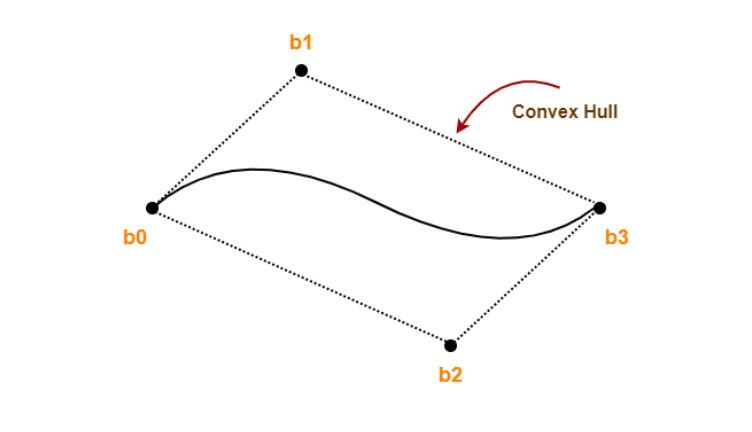
Bezier curve generally follows the shape of its defining polygon. The first and last points of the curve are coincident with the first and last points of the defining polygon.
The degree of the polynomial defining the curve segment is one less than the total number of control points.
Degree = Number of Control Points – 1
The order of the polynomial defining the curve segment is equal to the total number of control points.
Order = Number of Control PointsBezier curve exhibits the variation diminishing property. It means the curve do not oscillate about any straight line more often than the defining polygon.
02 . Bezier Curve Equation 🔢
A bezier curve is parametrically represented by-
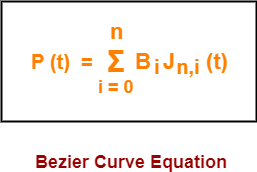
Here,
t is any parameter where 0 <= t <= 1
P(t) = Any point lying on the bezier curve
Bi = ith control point of the bezier curve
n = degree of the curve
Jn,i(t) = Blending function = C(n,i)ti(1-t)n-i where C(n,i) = n! / i!(n-i)!
Let us derive the equation for a cubic bezier curve. Cubic bezier curve is a bezier curve with degree 3. The total number of control points in a cubic bezier curve is 4.
The following curve is an example of a cubic bezier curve-
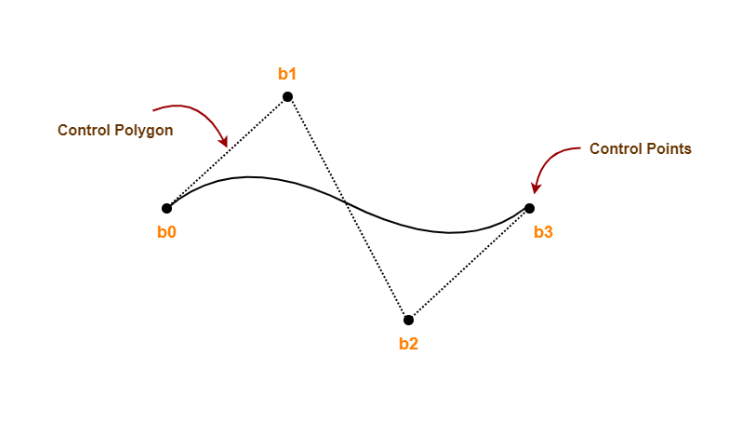
Now, we have seen above that the parametric equation of Bezier Curve is
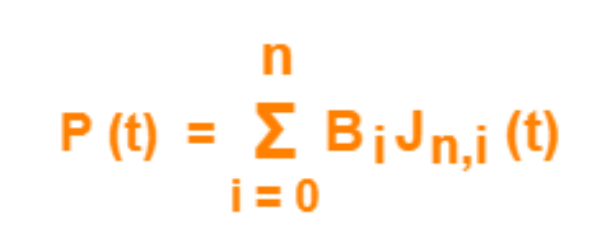
Substituting n=3, we get

Expanding the above equation, we get:
P (t) = B0J3,0(t) + B1J3,1(t) + B2J3,2(t) + B3J3,3(t)
Now,

Similarly,

Also,

And,

Using the above five equations, we can say that
P(t) = B0(1-t)3 + B13t(1-t)2 + B23t2(1-t) + B3t3
This is the parametric equation of a cubic bezier curve. We can similarly derive for a linear bezier curve and a quadratic bezier curve.
There are several applications of Bezier Curves.
03 . Applications of Bezier Curves ✨
The following are some of the important applications of Bezier Curves.
Bezier curves are widely used in computer graphics to model smooth curves. The curve is completely contained in the convex hull of its control points. So, the points can be graphically displayed & used to manipulate the curve intuitively.
Bezier curves are used to outline movement in animation applications such as Adobe Flash and synfig. Users outline the wanted path in bezier curves. The application creates the needed frames for the object to move along the path. For 3D animation, bezier curves are often used to define 3D paths as well as 2D curves.
True type fonts use composite bezier curves composed of quadratic bezier curves.
04 . Solved Example 🔑
What better way to end an article than solving a numerical? So, let us solve a numerical on Bezier Curve.
The question is: Given a bezier curve with 4 control points- B0[1 0] , B1[3 3] , B2[6 3] , B3[8 1]. Determine any 5 points lying on the curve. Also, draw a rough sketch of the curve.
We have-
The given curve is defined by 4 control points.
So, the given curve is a cubic bezier curve.
The parametric equation for a cubic bezier curve is-
P(t) = B0(1-t)3 + B13t(1-t)2 + B23t2(1-t) + B3t3
Substituting the control points B0, B1, B2 and B3, we get-
P(t) = [1 0](1-t)3 + [3 3]3t(1-t)2 + [6 3]3t2(1-t) + [8 1]t3 ……..(1)
Now, To get 5 points lying on the curve, assume any 5 values of t lying in the range 0 <= t <= 1.
Let 5 values of t are 0, 0.2, 0.5, 0.7, 1
For t = 0:
Substituting t=0 in (1), we get-
P(0) = [1 0](1-0)3 + [3 3]3(0)(1-t)2 + [6 3]3(0)2(1-0) + [8 1](0)3
P(0) = [1 0] + 0 + 0 + 0
P(0) = [1 0]
For t = 0.2:
Substituting t=0.2 in (1), we get-
P(0.2) = [1 0](1-0.2)3 + [3 3]3(0.2)(1-0.2)2 + [6 3]3(0.2)2(1-0.2) + [8 1](0.2)3
P(0.2) = [1 0](0.8)3 + [3 3]3(0.2)(0.8)2 + [6 3]3(0.2)2(0.8) + [8 1](0.2)3
P(0.2) = [1 0] x 0.512 + [3 3] x 3 x 0.2 x 0.64 + [6 3] x 3 x 0.04 x 0.8 + [8 1] x 0.008
P(0.2) = [1 0] x 0.512 + [3 3] x 0.384 + [6 3] x 0.096 + [8 1] x 0.008
P(0.2) = [0.512 0] + [1.152 1.152] + [0.576 0.288] + [0.064 0.008]
P(0.2) = [2.304 1.448]
For t = 0.5:
Substituting t=0.5 in (1), we get-
P(0.5) = [1 0](1-0.5)3 + [3 3]3(0.5)(1-0.5)2 + [6 3]3(0.5)2(1-0.5) + [8 1](0.5)3
P(0.5) = [1 0](0.5)3 + [3 3]3(0.5)(0.5)2 + [6 3]3(0.5)2(0.5) + [8 1](0.5)3
P(0.5) = [1 0] x 0.125 + [3 3] x 3 x 0.5 x 0.25 + [6 3] x 3 x 0.25 x 0.5 + [8 1] x 0.125
P(0.5) = [1 0] x 0.125 + [3 3] x 0.375 + [6 3] x 0.375 + [8 1] x 0.125
P(0.5) = [0.125 0] + [1.125 1.125] + [2.25 1.125] + [1 0.125]
P(0.5) = [4.5 2.375]
For t = 0.7:
Substituting t=0.7 in (1), we get-
P(t) = [1 0](1-t)3 + [3 3]3t(1-t)2 + [6 3]3t2(1-t) + [8 1]t3
P(0.7) = [1 0](1-0.7)3 + [3 3]3(0.7)(1-0.7)2 + [6 3]3(0.7)2(1-0.7) + [8 1](0.7)3
P(0.7) = [1 0](0.3)3 + [3 3]3(0.7)(0.3)2 + [6 3]3(0.7)2(0.3) + [8 1](0.7)3
P(0.7) = [1 0] x 0.027 + [3 3] x 3 x 0.7 x 0.09 + [6 3] x 3 x 0.49 x 0.3 + [8 1] x 0.343
P(0.7) = [1 0] x 0.027 + [3 3] x 0.189 + [6 3] x 0.441 + [8 1] x 0.343
P(0.7) = [0.027 0] + [0.567 0.567] + [2.646 1.323] + [2.744 0.343]
P(0.7) = [5.984 2.233]
For t = 1:
Substituting t=1 in (1), we get-
P(1) = [1 0](1-1)3 + [3 3]3(1)(1-1)2 + [6 3]3(1)2(1-1) + [8 1](1)3
P(1) = [1 0] x 0 + [3 3] x 3 x 1 x 0 + [6 3] x 3 x 1 x 0 + [8 1] x 1
P(1) = 0 + 0 + 0 + [8 1]
P(1) = [8 1]
Following is the required rough sketch of the curve-
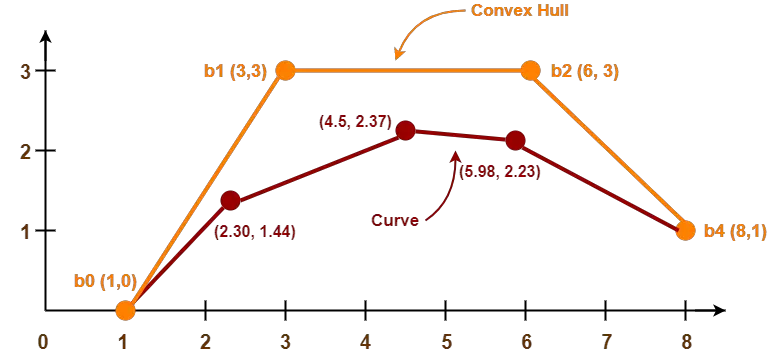
This was all about Bezier Curves. See ya.
Subscribe to my newsletter
Read articles from Dhruvvv directly inside your inbox. Subscribe to the newsletter, and don't miss out.
Written by

Dhruvvv
Dhruvvv
A Flutter Developer, Unity Developer and Product Manager.